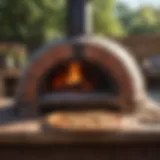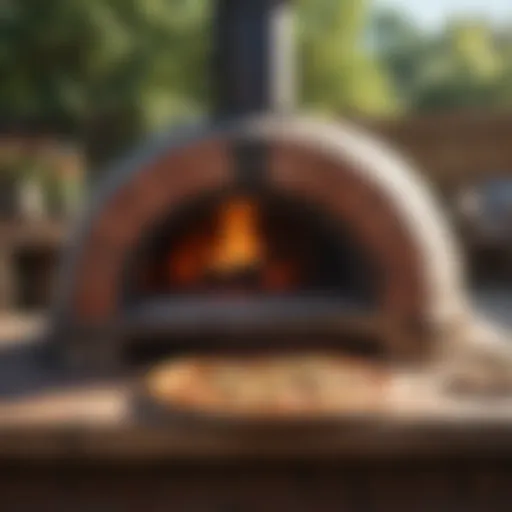The Essential Guide to Pizza Peels for Wood-Fired Ovens
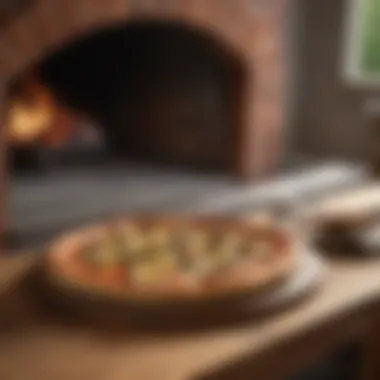

Intro
In the realm of making pizza, the choice of tools can significantly influence the outcome. A pizza peel, especially designed for wood-fired ovens, serves as a crucial instrument in achieving that perfect crust and flavorful toppings. Understanding the specific characteristics of a pizza peel is essential for anyone looking to elevate their pizza-making experience.
The following sections intend to explore the different types of pizza peels, their materials, dimensions, and the significant role they play in the pizza-making process. Readers will gain insights into how to select the appropriate peel, effective handling methods, and maintenance practices. Common pitfalls and alternative tools will also be discussed, thus catering to both beginners and veterans in the art of pizza-making.
Prelims to Pizza Peels
Pizza peels are essential tools for anyone who enjoys the art of pizza-making, especially when using wood-fired ovens. They are the bridge between the preparation area and the hot oven, significantly influencing the cooking process. Choosing the right pizza peel can enhance the experience of making pizza, ensuring a smooth transition from counter to oven. The correct peel helps in achieving the desired texture and crispness of the crust after cooking.
Additionally, a pizza peel is not merely a flat surface; it is a key instrument in controlling heat and moisture, which are critical components in baking the perfect pizza. By gaining insights into the various types of peels, the materials they are made from, and their sizing options, pizza lovers can make informed choices tailored to their specific needs.
Understanding how to use and maintain a pizza peel is equally imperative. Proper techniques for handling will prevent accidents and ensure every pizza comes out perfectly cooked. This section serves as an introduction to those considerations, setting the stage for a deeper examination of pizza peels within this guide.
Definition and Purpose of a Pizza Peel
A pizza peel typically consists of a long handle and a flat surface, designed specifically for transferring pizzas in and out of the oven. Peels come in various sizes and materials, each serving a unique purpose. Their fundamental role is to serve as a tool that allows the user to slide uncooked pizzas into the oven and retrieve them once baked.
The flat surface of the peel provides stability, allowing for proper support of the pizza. The handle grants the necessary reach to handle hot pizzas comfortably, avoiding burns or accidents.
In wood-fired cooking, where temperatures can soar, the right peel helps maintain safety and efficiency. With the heat being concentrated at the oven's entrance, a suitable peel will also help in monitoring the bake as pizzas rotate within the high-heat environment.
Historical Context of Pizza Peels
The history of pizza peels is rich and intertwined with the evolution of pizza itself. Dating back hundreds of years, peels have been used in various cultures for baking bread and other flatbreads. Ancient civilizations utilized similar tools, often made from wood or metal, to handle their baked goods.
In Italy, the craft of pizza-making became an art form, particularly in Naples. Here, the first modern pizza pushes towards the authentic Neapolitan style were born. Pizza peels were essential for these artisans, allowing them to maneuver pizzas quickly in their traditional wood-fired ovens.
As wood-fired ovens began to appear in homes, the design and usage of pizza peels adapted. Today, various materials, such as wood, metal, and composites, provide more hybrid solutions tailored to modern cooking needs while maintaining the essence of traditional methods. Understanding this historical context reinforces the appreciation of these tools and their significance in pizza culture.
Types of Pizza Peels
The type of pizza peel you choose plays a crucial role in your wood-fired oven experience. Each type has unique features, benefits, and areas of application. Understanding these distinctions allows you to select the peel that best aligns with your cooking goals. This section will discuss three primary types of pizza peels: wooden, metal, and composite. Each type has its own merits and ideal use cases, affecting your pizza-making efficiency and overall results.
Wooden Pizza Peels
Wooden pizza peels are traditional in pizza making, offering a classic approach for enthusiasts. They are typically lightweight and provide a sufficient surface area for transferring pizzas into and out of the oven. The unique texture of wood provides a natural non-stick surface, which is essential for your dough.
However, wooden peels require special care. They should not be soaked in water, as moisture can warp the wood. Regularly oiling and seasoning the wooden surface will help maintain its longevity and functionality.
Advantages of wooden pizza peels include:
- Gentle on Dough: The wood helps to prevent the pizza from sticking.
- Classic Aesthetic: Many home chefs enjoy the rustic look of wood.
- Heat Insulation: Wood does not conduct heat as rapidly as metals, which can help with a safer handling experience.
Despite these benefits, there are limitations. Wooden peels might not slide as easily under a well-cooked pizza in extremely high temperatures. Thus, understanding the specific use scenario when utilizing wooden peels is essential for optimal results.
Metal Pizza Peels
Metal pizza peels, typically made from aluminum or stainless steel, cater to a different set of needs. These peels are thin and rigid, allowing for easy sliding underneath a pizza crust. The smooth surface of metal peels enables effortless transfer of pizzas, particularly when dealing with high heat.
However, the advantages of metal peels also include some drawbacks. They tend to conduct heat, which can create a risk of burning the dough if not used correctly. In addition, metal can be heavier than wood, which can be a concern for some users.
Key points regarding metal pizza peels include:
- High Heat Resistance: They perform well at the high temperatures of wood-fired ovens.
- Durability: Metal peels withstand wear and tear better than wooden counterparts.
- Precision: The thin design allows for accurate positioning of the peel.
While metal peels might lack the aesthetic appeal of wood, their performance in high-temperature situations makes them a favored choice among professional pizza makers and more experienced enthusiasts.
Composite Material Peels
Composite material peels combine features from both wood and metal, offering a versatile option for pizza lovers. Typically made from a blend of materials, these peels aim to leverage advantages while minimizing drawbacks. They are often lightweight, durable, and possess a non-stick surface.
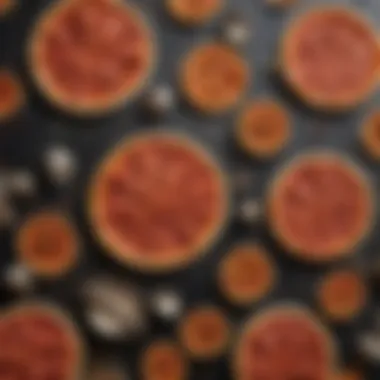

One of the primary benefits of composite peels is their versatility. They work well in varying conditions and with all kinds of pizzas. Additionally, many composite materials resist warping and tend to be easier to clean.
Benefits of composite pizza peels:
- Lightweight and Maneuverable: Easy for any user to handle in a busy kitchen setting.
- Dynamic Use: Well-suited for home cooks and professionals alike.
- Easy Maintenance: These materials often allow for quick cleaning without extensive care.
The emergence of composite peels reflects an evolution in pizza-making tools, combining the best characteristics while offering a functional alternative to traditional wooden or metal peels.
Each type of pizza peel contributes differently to your cooking experience, so choose wisely based on your preferred style and cooking conditions.
Material Considerations
When selecting a pizza peel for wood-fired ovens, understanding the materials involved is crucial. The right material influences not only usability but also the overall cooking experience. Each material comes with its own set of characteristics, advantages, and limitations. This section delves into the pros and cons of wooden pizza peels, the advantages of metal options, and the emerging choices in composite materials. Better comprehension of these factors can significantly enhance your pizza-making skills.
Pros and Cons of Wood
Wooden pizza peels have long been a favored choice among pizza enthusiasts. The natural characteristics of wood provide a unique aesthetic appeal and functional advantages. Here we outline the key benefits and potential drawbacks:
- Pros:
- Cons:
- Heat Resistance: Wood can handle high temperatures effectively, making it ideal for transferring pizzas into ovens.
- Non-Stick Surface: The porous surface reduces sticking, allowing easier transfer of pizza.
- Durability: With proper care, wooden peels can last for many years, contributing to a sustainable cooking tool.
- Weight: Wooden peels can be heavier than their metal counterparts, which may lead to wrist fatigue during prolonged use.
- Maintenance: They require regular oiling and careful cleaning to maintain their condition, making them somewhat labor-intensive.
Advantages of Metal
Metal pizza peels present unique advantages that are hard to overlook. Their construction gives them specific qualities that can enhance the pizza-making experience:
- Durability: Metal peels are generally more robust and weather any kitchen environment.
- Light Weight: This allows for easy handling, minimizing the physical strain on the user.
- Thin Edge: The thinner edge can slide under pizza easily, helping with smooth transfers into the oven.
- Temperature Conductivity: Metal can distribute heat more evenly, which can lead to a better crust when retrieving pizzas.
However, some downsides include potential stickiness if not monitored correctly and the need for a smooth, flat surface to function optimally.
Exploring Composite Options
Composite materials in pizza peels are gaining traction, combining the benefits of both wood and metal. They are often designed to provide a balanced approach:
- Lightweight and Sturdy: Composite peels tend to offer a robust feel while remaining lightweight, making them easy to handle.
- Non-Stick Properties: Many composites are manufactured with non-stick surfaces, allowing for easy pizza sliding.
- Reduced Maintenance: These peels are often dishwasher-safe or easier to clean than traditional wood peels.
"Choosing the right material for your pizza peel can make a significant difference in your baking results. Whether wood, metal, or composite, each has its unique set of benefits."
Choosing the Right Size
Choosing the right size of pizza peel is crucial for both efficiency and ease during the pizza-making process, especially in wood-fired ovens. An appropriate peel size facilitates a smooth transfer of pizzas, enabling better control over the cooking experience. Pizza peels come in various dimensions, and understanding these can significantly impact how one prepares and serves the final product.
Standard Dimensions for Home Ovens
For home ovens, the standard peel sizes typically range from 12 to 16 inches. A 12-inch peel is suitable for smaller pizzas or personal-sized servings, whereas a 14 to 16-inch peel is more versatile for larger pizzas and family gatherings. When selecting a peel, consider the size of your cooking surface and the dimensions of the pizzas you prefer to make. If a home chef regularly makes larger pies, investing in a larger peel can save time during the baking process. The extra space allows for easy sliding in and out of the oven without the risk of damaging the pizza.
Adjusting for Oven Size
Adjusting the peel size based on the specific dimensions of your oven is equally important. Wood-fired ovens typically have varying sizes, from compact models to larger, more traditional setups. A smaller oven demands a smaller peel to ensure maneuverability. Conversely, a larger oven provides the flexibility to use bigger peels.
Here are some considerations when adjusting for oven size:
- Space inside the oven: Ensure that your chosen peel can fit within the confines of the oven without limitation.
- Heat distribution: A peel that matches the oven's capacity allows for even heat distribution, ensuring the pizza cooks well.
- Personal preferences: Individual cooking styles and preferences will also influence the choice. Some cooks prefer a more substantial peel for stability, while others might opt for a smaller size for precision.
Finding the right balance between your pizza's size and your oven's dimensions will ensure a more pleasant cooking experience, leading to better results in flavor and presentation.
Ergonomics and Design Features
When selecting a pizza peel, ergonomics and design features play crucial roles in ensuring ease of use and efficiency. A well-designed peel enables the user to maneuver their pizza with minimal strain, which is key when operating a wood-fired oven. Considerations like handle length, shape, and weight distribution directly impact comfort and control during the pizza-making process.
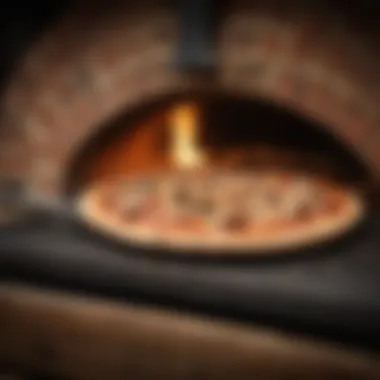

Handle Length and Comfort
The length of the handle significantly affects how a pizza peel is used. A longer handle keeps the user's hands away from the intense heat of the oven, reducing the risk of burns. However, if the handle is too long, it can become unwieldy and difficult to control.
Finding a balance is important. A comfortable grip is essential, often featuring ergonomic designs that allow for easy maneuvering. Many handles are made from materials like wood or silicone that provide a secure grip. Ensuring that the peel feels natural in your hands can enhance your pizza-making experience.
Shape Variations
The shape of the pizza peel can also influence how pizzas are transferred in and out of the oven. Most peels have a large, flat surface to accommodate different pizza sizes, but some variations include rounded or rectangular edges. A rounded edge helps with sliding the pizza off and onto the stone or plate more easily, while a rectangular shape can offer stability when supporting larger pizzas.
Different shapes can also affect how many pizzas one can manage at once. Wider peels allow for broader support, making it possible to slide multiple smaller pizzas simultaneously. Regardless of shape, it is essential to choose one that complements the user's style and preference.
Ergonomics in pizza peels ensure that cooking remains an enjoyable, stress-free experience while minimizing injury risk.
Proper Handling Techniques
When using a pizza peel for wood-fired ovens, proper handling techniques are crucial for both safety and the quality of the final product. Mastering these techniques helps prevent accidents, ensures a successful pizza transfer, and maintains the integrity of the pizza. A well-handled peel allows for more control and precision, which are essential for cooking crispy crusts and achieving optimal results.
Sliding vs. Lifting Pizzas
The two primary techniques for transferring pizzas using a peel are sliding and lifting. Each has its own set of advantages and considerations.
Sliding Pizzas: This method entails gently pushing the pizza onto the oven stone. It requires a smooth, quick motion and a bit of practice to execute properly. When sliding, it's essential to ensure that the pizza is not sticking to the peel by lightly dusting the surface with flour or cornmeal before placing the dough. This creates a non-stick layer, allowing the pizza to glide off effortlessly.
Lifting Pizzas: In contrast, lifting involves raising the pizza off the peel and onto the oven surface. This technique can be useful for pizzas that have already been pre-cooked or for styles that require a slightly longer cooking time. It requires a steady hand to avoid damaging the pizza. Regardless of the method chosen, both techniques necessitate confidence and assurance when working with a hot oven.
Maintaining Grip and Control
Grip and control are paramount when handling a pizza peel. A slip could result in a ruined pizza or, worse, a burned hand. Here are some tips to enhance grip and control:
- Handle Design: Choose a peel with a comfortable, ergonomically designed handle. This creates a secure grip during use.
- Surface Preparation: Ensure the peel surface is adequately prepared before placing the pizza. Use a mix of flour and cornmeal to help the pie slide without sticking.
- Body Positioning: When transferring the pizza, maintain a stable stance. Position your body close to the oven if needed to avoid excessive reaches that may compromise balance.
- Practice: Like any skill, mastering grip and control comes with practice. Rehearse transferring pizzas with uncooked dough a few times before attempting a full version.
Proper handling techniques not only elevate the cooking experience, but also maximize safety in the kitchen. Prioritizing these techniques ensures that pizza night can be a delightful event rather than a source of frustration.
Maintenance and Care
Proper maintenance and care of pizza peels extend their lifespan and ensure they perform effectively. A well-cared-for pizza peel can significantly enhance your pizza-making experience by promoting hygiene and optimal cooking results. Neglecting this aspect can lead to deterioration of the peel materials, which indirectly affects the quality of your pizzas. This section highlights how to maintain both wooden and metal pizza peels properly.
Cleaning Wooden Peels
Wooden pizza peels require specific attention in terms of cleaning. Wood is porous, meaning it can absorb moisture and odors if not handled correctly. A few best practices for cleaning your wooden peel include:
- Immediate Cleaning: After use, scrape off any excess flour or residue. It is crucial to clean the peel soon after use to prevent food particles from sticking firmly.
- Avoid Soaking: Do not soak your wooden peel in water. Prolonged exposure can warp the wood and promote bacterial growth. Instead, wipe it down with a damp cloth.
- Use Gentle Cleaners: Mild soap, if necessary, can help with stubborn stains. However, rinse thoroughly to remove any soap residue, as strong chemicals can leave undesirable tastes.
- Periodic Oiling: Applying food-grade mineral oil every few months can help maintain the wood's integrity. This practice can prevent cracking and prolong the life of the peel by keeping the wood moisturized.
By following these cleaning techniques, you can ensure that your wooden peel remains both functional and hygienic.
Maintaining Metal Peels
Metal pizza peels are generally easier to maintain compared to their wooden counterparts. Nonetheless, some specific care tips ensure your metal peel lasts:
- Basic Cleaning Routine: After each use, clean the surface with warm soapy water. This helps remove food particles and grease that can accumulate.
- Abrasive Materials: Avoid using steel wool or harsh abrasives that can scratch and damage the surface. Instead, opt for soft sponges for effective cleaning.
- Drying: After washing, dry your metal peel immediately. Leaving it wet can cause rusting, especially if the peel has a steel construction.
- Storage Practices: Store the metal peel in a dry environment to prevent exposure to moisture. Using a protective cover can also be an effective measure against scratches during storage.
These maintenance steps ensure that your metal pizza peel remains in excellent condition, ready for each pizza night.
Important Note: Regular maintenance is essential whether you choose wood or metal peels. Each type has unique care requirements that, if followed, lead to improved performance and longevity.
Common Mistakes to Avoid
Understanding common mistakes when using pizza peels is crucial for achieving optimal pizza-making results. Neglecting proper techniques often leads to frustration and subpar pizzas. This section highlights key pitfalls and offers guidance on avoiding them.
Overloading the Peel


One of the most frequent mistakes is overloading the peel with too many toppings or ingredients. A heavily loaded peel may cause the pizza to stick or become impossible to slide off into the oven. The weight distribution is critical here. When the peel is overloaded, it changes the balance, which can lead to uneven cooking or a ruined base. Aiming for a moderate amount of toppings allows for better handling.
To prevent this issue, consider the following:
- Stick to moderate amounts: Use a balance of toppings that complements the dough without overwhelming it.
- Layer ingredients wisely: Try to place heavier items like vegetables in the center and lighter items on the edges to maintain stability.
- Practice your technique: Sliding a pizza onto the peel should feel smooth, and this requires familiarity with how much weight the peel can support.
By being mindful of what you place on the peel, you increase your chances of a successful transfer to the oven, enhancing the overall cooking experience.
Incorrect Heat Treatment
Another common error is applying improper heat treatment to the pizza peel. Metal peels require a different treatment than wooden peels. For instance, heating a metal peel before using it can prevent the pizza from sticking. However, if the peel is too hot, it can cause the dough to cook prematurely before it reaches the oven.
Here are some considerations for correct heat treatment:
- Preheat metal peels: A slight heating will enhance non-stick properties without compromising the dough.
- Avoid high heat for wood peels: Wooden peels can scorch if placed in the oven’s direct heat, impacting the flavor and safety of your pizza.
- Check temperature regularly: Make sure to monitor how hot the peel becomes and adjust your method accordingly.
Correct heat treatment not only preserves the quality of your ingredients but also ensures consistent cooking results and safety in the kitchen.
Alternative Tools for Pizza Making
Exploring alternative tools for pizza making is vital for both novices and experienced chefs alike. While pizza peels are the traditional choice for transferring pizzas to and from a wood-fired oven, other tools can provide similar functionality and convenience. Using the right tools ensures efficiency and enhances the overall pizza-making experience. The benefits of being aware of these alternatives include not only convenience but also versatility in cooking methods.
Using Baking Sheets
Baking sheets can serve as a practical alternative to pizza peels. Made of metal, they are often readily available in most kitchens. Their flat surfaces provide an ample area for preparing pizzas before placing them into the oven. A few considerations when using baking sheets include:
- Temperature Conductivity: Metal baking sheets absorb heat well, which can contribute to a nicely cooked pizza crust.
- Non-stick Surface: Many baking sheets come with non-stick coatings that can ease the transfer of the pizza, reducing the chance of sticking. However, it's advisable to sprinkle some flour or cornmeal on the sheet beforehand to ensure smooth release.
- Size and Shape: Baking sheets typically come in various sizes, making them versatile for any kitchen. However, it’s imperative to check if the baking sheet fits inside your wood-fired oven.
"Always ensure the baking sheet is preheated in the oven for the best results when baking pizza."
Despite the simplicity of a baking sheet, it may lack the long handle that is useful for reaching into hot ovens. However, it is still a commendable tool, especially in smaller settings or when preparing multiple pizzas at once.
Alternatives to Metal Peels
While metal peels are common, there are alternatives that can maintain similar functionality. Some of these include:
- Silicone Baking Mats: These mats can withstand high temperatures and provide a non-stick surface for easy pizza transfer. They are also easy to clean and can be rolled up for storage, making them a practical choice.
- Wood or Bamboo Boards: While they may function similarly to pizza peels, these boards can serve as serving trays as well. Their aesthetics might also enhance the presentation of the pizza at the table, making them a dual-purpose tool.
- Pizza Screens: These mesh-like surfaces allow for even heat circulation while baking and ensure a crispy crust. They can be less cumbersome than traditional peels when removing a pizza from the oven.
- Cast Iron Skillet: A skillet can double as a baking surface. Preheating it in the oven can yield a steaming hot base for the pizza, giving it a crisp crust.
In essence, while the traditional pizza peel remains essential, many alternative tools can be effectively utilized for pizza making. Being open to using various tools allows for flexibility and innovation in the kitchen, leading to better results and a more enjoyable cooking process.
Wrapping Up: Key Takeaways
As we reach the conclusion of this guide, reflecting on the insights gained about pizza peels for wood-fired ovens underscores their significance in crafting the perfect pizza. The selection, use, and maintenance of a pizza peel are more than mere practical considerations; they represent the bridge between an idea and a delicious reality.
Choosing the correct type of pizza peel based on materials and size can greatly influence the ease of creating a flawless pizza crust. As you learned throughout this article, a wooden peel offers natural insulation, a metal peel provides an effortless slide, and composite materials can combine the best of both worlds. Each kind has distinct advantages that suit different cooking styles and personal preferences.
Maintaining these peels is also vital. Proper care extends the lifespan of the peel, ensuring a reliable cooking tool at your side for many pizza nights to come.
"An often overlooked yet essential part of the pizza-making process, the right peel enhances both technique and enjoyment in the kitchen."
The pitfalls to avoid, such as overloading the peel or mistreating the heat, can save you from frustrating experiences and poor results. Being aware of these errors makes one a more competent cook.
Along with the conventional tools, alternative methods can enrich your cooking journey. Understanding these options encourages creativity in the kitchen, allowing you to adapt and experiment without fear.
Summary of Essential Points
- Types of Pizza Peels: Each type—wood, metal, and composite—has unique benefits.
- Choosing the Right Size: Know your oven dimensions for a perfect fit.
- Proper Handling Techniques: Learning the right way to slide or lift will drastically improve your pizza-making skills.
- Maintenance: Keeping peels clean and well-cared-for is essential for performance and longevity.
- Common Mistakes: Avoid cluttering the peel or making the wrong temperature adjustments for optimal results.
- Alternative Tools: Baking sheets and similar implements can serve as substitutes when needed.
- Wood Peels: Natural, good insulation, but heavier.
- Metal Peels: Thin, easy to slide underneath pizza, but may conduct heat.
- Composite Peels: Mix of materials, offering diverse benefits.
- Standard peels cater to most home ovens, while larger models suit commercial needs.
Final Recommendations
To enhance your pizza-making experience, reflect on the following recommendations:
- Invest Wisely: Spend some time researching the best pizza peel suited for your style, considering both material and size.
- Practice Regularly: The more you use your peel, the more proficient you will become.
- Prioritize Care: Regular cleaning and careful handling ensure your peel remains in top condition.
- Stay Informed: Keep up with trends and techniques in pizza-making to continuously improve your skills.
As you begin or continue your pizza-making journey, these key takeaways serve to remind you of the crucial role a pizza peel plays. Understanding your tools allows you to enjoy this culinary art form to the fullest, elevating not only your own skills but also the experience of those who partake in your creations.
